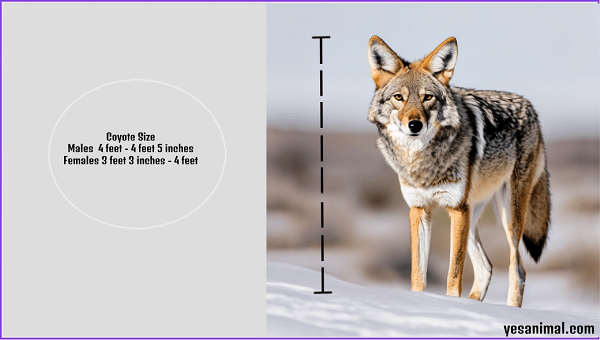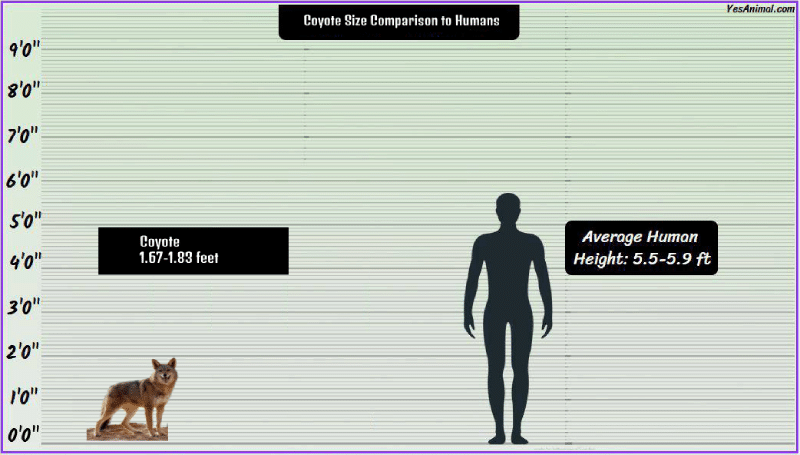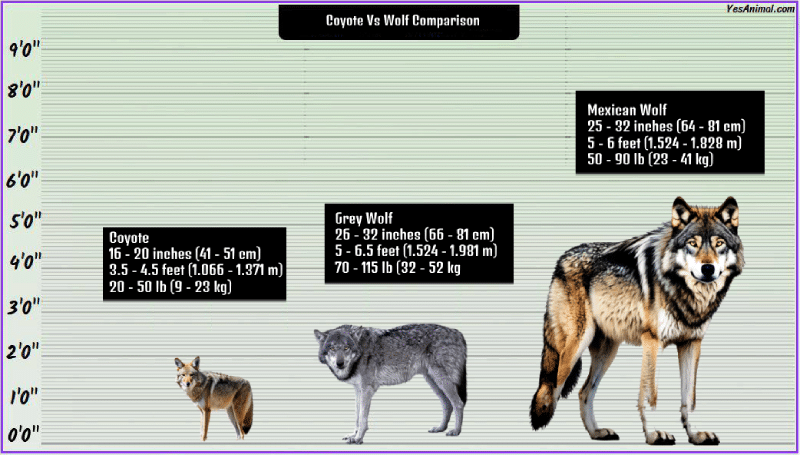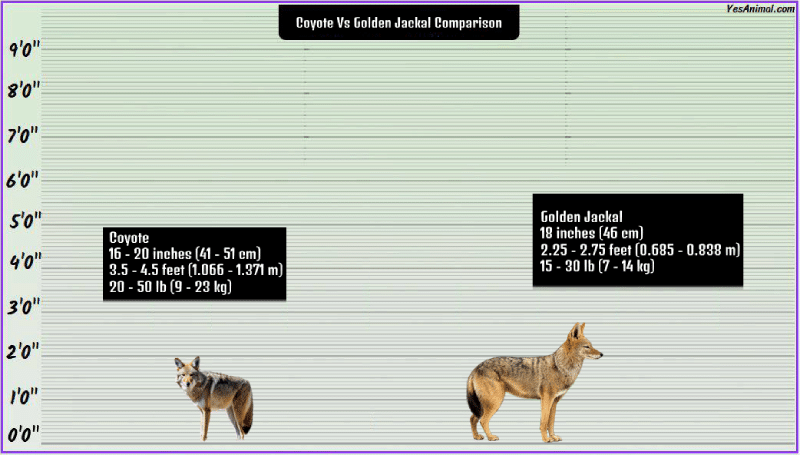Last Updated on March 10, 2024 by Amin Tawar

Coyotes (Canis latrans) are some of the most ubiquitous canines found in North America, roaming around all over the continent. It’s difficult to map their exact size since there’s quite a few subspecies that occur naturally. However, they’re generally considered to be somewhat smaller than wolves.
Coyote Height and Length
Coyotes generally aren’t very big animals. In fact, it’s bound to be smaller than many of your domesticated dog breeds like German Shepherds or Labradors. The northern coyotes are slightly larger and heavier than the coyotes found in the southern latitudes.
On average, a coyote stands at a height of 50 – 55 cm at the shoulder. The total length of the coyote, from nose to tail is just over 1 m. The long fluffy tail makes up a large portion of this length. Females tend to be slightly smaller than males both height and lengthwise.
| Length | Feet | Meters |
| Males | 4 feet – 4 feet 5 inches | 1.219 – 1.346 |
| Females | 3 feet 3 inches – 4 feet | 0.990 – 1.219 |
Coyote Weight
Coyotes are small and lithe. They weigh just about 20 – 25 lbs on average. However, that’s just the case for the western coyotes which are mostly pureblood.
The eastern coyote, which has some wolf blood, tends to be a little bigger and weigh about 30 – 35 lbs. However, most biologists consider eastern coyotes to be mixed breeds and don’t really count them in the statistics.
Females are smaller and lighter than males and don’t weigh as much. Their weight ranges between 7 and 18 kg (15 – 40 lb). For males, it’s about 8 to 20 kg (18 – 44 lb).
| Weight | Pounds | Kilograms |
| Males | 18 – 44 | 8 – 20 |
| Females | 15 – 40 | 7 – 18 |
A fully grown coyote from the northern regions average at about 18 kg (40 lb) but in the more southern regions like Mexico, the average is 11.5 kg (25 lb).
Coyote Tail and Head Size
The coyote has a truly lovely tail to be proud of. Bushy, thick and long, it makes up a large portion of the total length of the coyote. Most coyotes have tails that range between 30 and 40 cm (11.8 – 15.7 inches). It’s one of the distinguishing factors between coyotes and wolves, since wolves don’t have such bushy tails.
For their small size, coyotes have an abnormally long skull. With a slender muzzle and a sloping forehead, the coyote skull measures around 18 cm (7 inches) from the front to the back. This also sets coyotes apart from wolves, whose skulls are much broader.
Coyote Litter Size
Coyotes are, very interestingly, strictly monogamous. A male coyote does not go looking for multiple partners during the reproductive process and help with the raising of the pups. They can maintain monogamous bonds for multiple years.
An average litter is about 4 to 7 puppies. However, the amount of food available or the density of coyotes in that particular region can make this number vary. There have been reports of litters that have 11 – 19 pups but this might have been due to the sharing of a den by two females. The gestation period is just over 2 months, at 63 days.
Coyote Baby Size
At the time of birth, coyote babies weigh only 200 to 400 grams (0.44 – 1.10 lb). They’re blind for the first few days of their birth and open their eyes around the sixth day. Male puppies leave their mother by the time they’re six months old but female puppies might stay on with the pack for years.
Coyote Size Comparison to Humans

A coyote, after all, isn’t very tall. It stands just about 20 – 22 inches (50 – 55 cm) at the shoulder. For the average human, who stands at about 5 feet 9 inches, that’s less than waist high.
They’re also pretty light animals, weighing just about 8 – 20 kg (18 – 44 lb). The average human, on the other hand, weighs 162 kg or 137 lb. Thus, for us, a coyote would compare to a medium sized dog.
Coyote Vs Wolf Comparison

The American animal that coyotes most often get confused with is the grey wolf (in the north) or the Mexican wolf (in the south). But actually, the size difference between the two is quite significant. Coyotes are much smaller than wolves.
Coyotes stand at about 55 cm or 22 inches at the shoulder. Wolves would stand at 76 cm or 30 inches at the shoulder. Coyotes measure between 3.3 to 4.3 feet (1 – 1.3 m) from nose to tail while wolves measure almost 6.6 feet or 2 m. The weight difference is also quite a lot, with the largest wolves weighing in at 80 kg or 176 lbs as compared to the 22.7 kg (50 lbs) that the largest coyote can reach.
The Mexican wolf is slightly smaller than the grey wolf at 5 – 6 feet (1.5 – 1.8 m) length and 64 cm or 25 inches height. But it’s still bigger than the coyote.
| Animal | Height | Length | Weight |
| Coyote | 16 – 20 inches (41 – 51 cm) | 3.5 – 4.5 feet (1.066 – 1.371 m) | 20 – 50 lb (9 – 23 kg) |
| Mexican Wolf | 25 – 32 inches (64 – 81 cm) | 5 – 6 feet (1.524 – 1.828 m) | 50 – 90 lb (23 – 41 kg) |
| Grey Wolf | 26 – 32 inches (66 – 81 cm) | 5 – 6.5 feet (1.524 – 1.981 m) | 70 – 115 lb (32 – 52 kg) |
Coyote Vs Golden Jackal Comparison

Despite the name, the European golden jackal is actually much more closely related to coyotes and wolves than other jackals. Coyotes are slightly larger than the golden jackal and weightier as well. Golden jackals stand at about 18 inches at the shoulder and have a body length of about 27 – 33 inches.
| Animal | Height | Length | Weight |
| Coyote | 16 – 20 inches (41 – 51 cm) | 3.5 – 4.5 feet (1.066 – 1.371 m) | 20 – 50 lb (9 – 23 kg) |
| Golden Jackal | 18 inches (46 cm) | 2.25 – 2.75 feet (0.685 – 0.838 m) | 15 – 30 lb (7 – 14 kg) |
FAQ
Conclusion
That is all that you need to know about the size of the coyote. I hope this article was helpful enough and that you got something valuable from it.